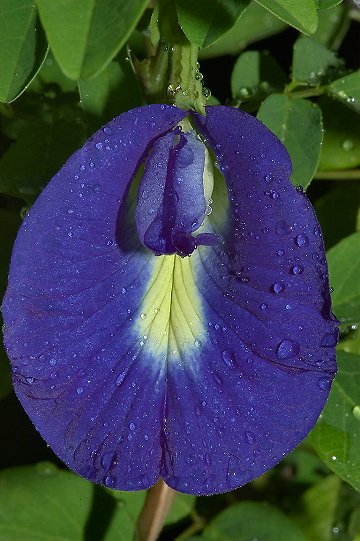
|
|
Butterfly Pea (Clitoria ternatea).
Flower
|
Butterfly Pea - Clitoria ternatea
Clitoria is a genus of flowering plants that are insect pollinated. These plants are native to tropical and temperate areas of the world, including southeast Asia and Madagascar, where the flowers are often used as a food dye or dipped in batter and
deep-fried. The most widely known species of the genus is Clitoria ternatea, also known as Butterfly pea. It has medicinal uses and it is used as food as well. Its roots are used in ayurveda Indian
medicine.
This genus was named after the human female clitoris, for the flowers bear a resemblance to female genitals. Originally the first described species of the genus was given the name Flos clitoridis ternatensibus in 1678 by Rumpf, a German-born botanist employed by the Dutch East India Company. It was regarded as appropriately named by Johann Philipp Breyne in 1747. Many vernacular names of these flowers in different languages are similarly based on references to a woman's sexual
organ.
There were controversies in the past among botanists regarding the good taste of the naming of the genus. The analogy drew sharp criticism from botanists like James Edward Smith in 1807, Amos Eaton in 1817, Michel Etienne Descourtilz in 1826 and Eaton and Wright in 1840. Some less explicit alternatives, like Vexillaria (Eaton 1817) and Nauchea (Descourtilz 1826), were proposed, but they didn't prosper and the name Clitoria has survived to this
day.
Clitoria ternatea, common names including butterfly-pea, blue-pea, and
cordofan-pea, is a plant species belonging to the Fabaceae family. The flowers of this vine have the shape of human female
genitals, hence the Latin name of the genus "Clitoria", from "clitoris".
(Synonyms: Clitoris principissae). This plant is native to tropical equatorial
Asia, but has been introduced to Africa, Australia and America.
It is a perennial herbaceous plant, is a vigorous, trailing, scrambling or climbing tropical legume.Its sparsely pubescent stems are
sub-erect and woody at the base and may be up to 5 m long. They root only at the
tips. The leaves are pinnate, bearing 5-7 elliptical, 3-5 cm long
leaflets. It grows as a vine or creeper, doing well in moist, neutral
soil. The most striking feature about this plant are its vivid deep blue
flowers; solitary, with light yellow markings. They are about 4 cm long by 3 cm
wide. There are some varieties that yield white flowers. The fruits are
flat, 5 – 7 cm long,
linear, sparsely pubescent pods that dehisce violently at maturity and throw 8-10 dark and shiny
seeds. The fruits are edible when tender. There are numerous ecotypes, agro-types and cultivars that differ in flowers and
leaflets. Many cultivars have been bred in Latin America, notably in Cuba and
Mexico.
It is grown as an ornamental plant and as a revegetation species (e.g., in coal mines in
Australia), requiring little care when cultivated. As a legume, its roots form a symbiotic association with soil bacteria known as
rhizobia, which transform atmospheric N2 into a plant usable form,
therefore, this plant is also used to improve soil quality through the decomposition of
N-rich tissue.
The young pods are edible and used as vegetables in the Philippines. In Southeast Asia the flowers are used to colour
food. In Malay cooking, an aqueous extract is used to colour glutinous rice for kuih ketan
(also known as pulut tai tai in Peranakan/Nyonya cooking) and in nyonya
chang. In Kelantan it is used to colour white rice for Nasi Kerabu. In
Thailand, a syrupy blue drink is made called nam dok anchan, it is sometimes consumed with a drop of lime juice to increase acidity and turn the juice into
pink-purple. In Burmese and Thai cuisine the flowers are also dipped in batter and
fried.
Clitoria ternatea is a high-quality, protein-rich legume, a "tropical
alfalfa" often referred to as a protein bank that can be grown at low cost. Livestock tend to prefer it over other legumes and grasses and it is therefore much valued as a pasture
legume. It is also used for cut-and-carry feeding systems and cut for hay and
silage. A N-fixing legume, Clitoria ternatea is used as a ley legume or as green
manure. It is a valuable cover crop in rubber and coconut plantations.
In animal tests the methanolic extract of Clitoria ternatea roots demonstrated
nootropic, anxiolytic, antidepressant, anticonvulsant and antistress activity. The active constituents include
tannins, resins, starch, taraxerol and taraxerone.
Recently, several biologically active peptides called cliotides have been isolated from the
heat-stable fraction of Clitoria ternatea extract. Cliotides belong to the cyclotides family and activities studies show that cliotides display potent antimicrobial activity against E.
coli, K. pneumonia, P. aeruginosa and cytotoxicity against Hela cells. These peptides have potential to be lead compound for the development of novel antimicrobial and
anti-cancer agents.
In traditional medicine: Owing to its similarity to a human body part, this plant has been ascribed properties affecting the same (a phenomenon also found in connection with the
mandrake, among other plants). It was used traditionally in an attempt to treat sexual
ailments, like infertility and gonorrhea, to control menstrual discharge, and also as an
aphrodisiac. This practice aligns with an ancient belief recorded in the Doctrine of
Signatures.
In traditional Ayurvedic medicine, it has been used for centuries as a memory
enhancer, nootropic, antistress, anxiolytic, antidepressant, anticonvulsant, tranquilizing and sedative
agent.
Butterfly pea is also used in gardening. In fences and in trellises as an ornamental for its showy
flowers.
Source:
http://en.wikipedia.org/wiki/Clitoria
http://en.wikipedia.org/wiki/Clitoria_ternatea
http://www.feedipedia.org/node/318
